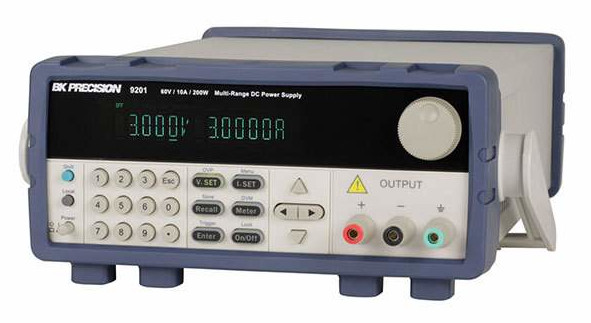Demo code showing how to control the B&K 9201 Programmable Power Supply with Python code. We will use pyvisa instead of direct USB or RS-232 serial.
We will be connecting the B&K 9201 through a USB cable, but pyvisa is useful because the same code can be used for USB, GPIB, or RS-232 instruments.
Install these Python modules:
pip install pyvisa
pip install pyvisa-py
pip install pyusb
The last part installs the USB backend pyvisa needs.
If using Linux, add your user to group plugdev:
- Add your user to group "plugdev" (USB device users). Example:
sudo addgroup myuser plugdev- Add a udev rule, for example create /etc/udev/rules.d/22-bk-9200-power-supply.rules with contents:
# B&K 920x Power Supply, give read/write permissions to group plugdev
SUBSYSTEMS=="usb", ACTION=="add", ATTRS{idVendor}=="ffff", ATTRS{idProduct}=="9200", GROUP="plugdev", MODE="0660"
This gives permissions to the group for that USB device.
The B&K 9201 defaults to RS-232 interface. Use the front-panel buttons to change the interface to USB. See the user manual for details on how to do this.
Use dmesg | tail to verify that Linux has indeed attached the device.
Use lsusb to find which USB bus the device is on. Look for ffff:9200 (USB Vendor ID and
Product ID of B&K 9201), like this:
$ lsusb
Bus 001 Device 002: ID 17ef:3074 Lenovo
Bus 001 Device 011: ID ffff:9200
Bus 001 Device 001: ID 1d6b:0002 Linux Foundation 2.0 root hub
In the example above, device was found on bus 001 as device 011. Use the bus and device number to check the permissions:
$ ls -l /dev/bus/usb/001/011
crw-rw-r-- 1 root plugdev 189, 10 Feb 13 12:19 /dev/bus/usb/001/011
It should show that the device is on group plugdev and the group has
read-write permissions to it.
You need to know what the resource string is to use when you refer to the instrument in your code. You can use a short Python program to list the instruments pyvisa found:
import visa
rm = visa.ResourceManager()
for line in rm.list_resources():
print lineWith B&K Precision 920x connected via USB, you will see something like this:
$ python list_resources.py
ASRL/dev/ttyS4::INSTR
USB0::65535::37376::802243020737510059::0::INSTR
The resource string you will need is the one that looks like below, except the long serial number will be unique to your device:
USB0::65535::37376::802243010737220006::0::INSTR
You then use pyvisa to send SCPI commands like the demo code below. Change the code for the specific resource string of your device.
import visa
rm = visa.ResourceManager()
pwr = rm.open_resource('USB0::65535::37376::802243010737220006::0::INSTR')
# Put device into remote control mode
pwr.write('SYST:REM')
# Set voltage to 5V
pwr.write('SOUR:VOLT 5.0')
# Set current to 1A
pwr.write('SOUR:CURR 1.0')
# Enable the output. '1' or 'ON' for enable, '0' or 'OFF' for disable.
pwr.write('SOUR:OUTP:STAT 1')For the B&K 9201 Power Supply, the user manual contains details on the SCPI commands supported.
